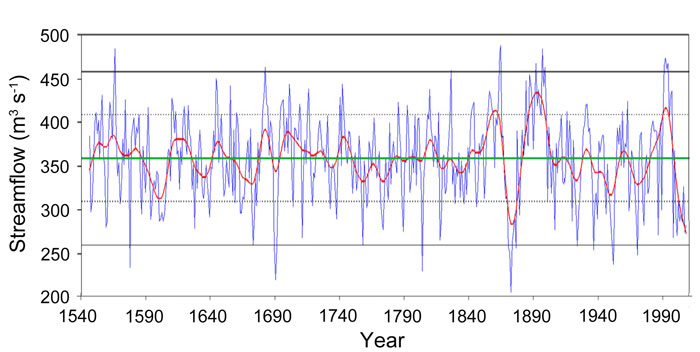| Tweet | Follow @co2science |
Paper Reviewed
Chen, F., Shang, H., Panyushkina, I.P., Meko, D.M., Yu, S., Yuan, Y. and Chen, F. 2019. Tree-ring reconstruction of Lhasa River streamflow reveals 472 years of hydrologic change on southern Tibetan Plateau. Journal of Hydrology 572: 169-178.
It is impossible to attribute any current extreme weather event to CO2-induced global warming if that event occurs within the realm of natural variability. And that is why it is important for scientists to continue to reconstruct climate indices beyond short-term instrumental records that are incapable of making such a determination.
Recently, Chen et al. (2019) produced a 472 year reconstruction of hydrologic change on the southern Tibetan Plateau, from which the natural variability of the Lhasa River could be examined. The streamflow record was derived using 85 tree-ring cores from 63 long-lived juniper trees (Juniperus tibetica), which were calibrated using climate and streamflow data observed during the period 1956-2017. The resultant August-July streamflow proxy, covering the period 1546-2017, is illustrated below.
As seen there, perhaps the most striking feature of the record is the short eight year decline in streamflow from the highest value (487.1 m3 s-1) in 1871 to the lowest value (205.4 m3 s-1) of the nearly five-century-long record, which sharp transition was a completely natural occurrence and could not have been due to CO2 (because the vast bulk of the modern CO2 rise has occurred over the past six decades). Aside from the above-mentioned event, the record displays considerable variability at multiple time scales, yet there is no obvious trend or indication that there is anything unusual, unnatural or unprecedented in recent years of the streamflow record that would indicate rising atmospheric CO2 is having an effect.
What is more, the authors performed spectral and wavelet analyses on the streamflow record and determined it contains multiple statistically significant periodicities at 34, 8.1, 5.7, 4.8, 3.8, 3.5, 3.2, 2.7, 2.3 and 2.1 years. Further analyses indicate these periodicities are likely natural in origin; they correspond well with and are likely significantly driven by ENSO, the Asian summer monsoon, and other large-scale climate circulation features.

Figure 1. Lhasa River streamflow reconstruction over the period 1546-2017 (blue line) with a 20-year low-pass filter curve (red line). The green horizontal line show the average reconstructed streamflow, the two dotted horizontal lines represent one standard deviation above/below the mean and the two outer solid black lines represent two standard deviations above/below the mean. Source: Chen et al. (2019).




